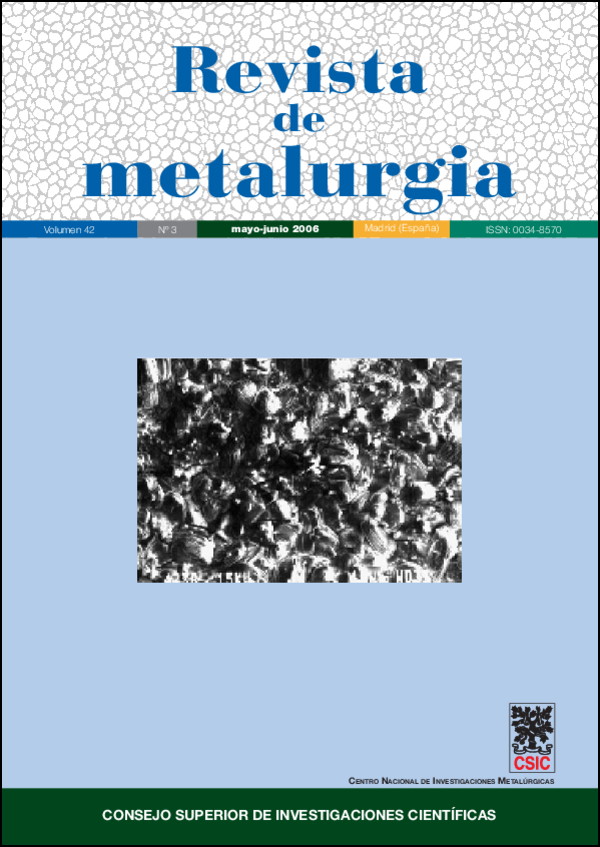Recovery of gold from solutions with ammonia and thiosulfate using activated carbon
DOI:
https://doi.org/10.3989/revmetalm.2006.v42.i3.22Keywords:
Adsorption, Elution, Gold, Activated carbon, Thiosulfate, AmmoniaAbstract
The recovery of gold from solutions containing thiosulfate and ammonia using granular activated carbon was studied, evaluating the adsorption and elution stages. The influence of ammonia and thiosulfate concentration and the presence of impurities such as copper and zinc were also evaluated. In the presence of ammonia there was a concentration which maximized the adsorption of gold, while thiosulfate and impurities presence was harmful for the adsorption of gold. During elution, ammonia and thiosulfate concentration, pH regulator and temperature were evaluated. Ammonia favored the process as long as thiosulfate showed a maximum starting from which the elution diminishes. The effect of the pH regulator was very important; If was revealed that when the pH was regulated with caustic ammonia, a synergic effect appeared which favored the elution. Temperature favored the elution process, with activation energy of 9.13 kJ/mol.
Downloads
References
[1] C. Abbruzzese, P. Fornyari, R. Massidda, F. Veglio andy S. Ubaldini, Hydrometallurgy 39 (1995) 265-276. doi:10.1016/0304-386X(95)00035-F
[2] W. T. Yen ET. AL., Proc. EPD Congress, 1999- Extraction andy Processing Division, B. Mishra (Ed.) San Diego, USA, 1999, pp. 441-455.
[3] K.N. Han andy M.C. Fuerstenau, Int. J. Miner. Process. 58 (2000) 369-381. doi:10.1016/S0301-7516(99)00046-0
[4] M. G. Aylmore andy D. M. Muir, Miner.Eng. 14 (2001) 135-174. doi:10.1016/S0892-6875(00)00172-2
[5] A. Villarroel, Trabajo de Titulación, Facultad de Ingeniería, Universidad de Santiago de Chile (Chile), 2001.
[6] P. Navarro, C. Vargas, A. Villarroel and F. J. Alguacil, Hydrometallurgy 65 (2002) 37-42. doi:10.1016/S0304-386X(02)00062-2
[7] D. M. Muir andy M. G. Aylmore, Mineral Miner. Processing. and Extractive Metallurgy C-113 (2004) C2-C12.
[8] G. Senanayake, Hidrometallurgy 75 (2004) 55- 75.
[9] G. Senanayake, Miner. Eng. 17 (2004) 785-801. doi:10.1016/j.mineng.2004.01.008
[10] E. Guerra andy D. Dreisinger, Hydrometallurgy 51 (1999) 155-172. doi:10.1016/S0304-386X(98)00061-9
[11] R. Álvarez, Tesis de Grado, Facultad de Ingeniería, Universidad de Santiago de Chile (Chile), 2002.
[12] P. Navarro, R. Álvarez, C. Vargas andy F. J. ALGUACIL, Miner. Eng. 17 (2004) 825-831. doi:10.1016/j.mineng.2004.02.001
[13] C. Vargas, G. Cifuentes, P. Navarro y P. Orrego, Rev. Metal. Madrid 40 (2004) 101-108.
[14] P. Navarro, C. Vargas, R. Álvarez y F. J. Alguacil, Rev. Metal. Madrid 41 (2005) 12-20.
[15] A. Villarroel, Tesis de Grado, Facultad de Ingeniería, Universidad de Santiago de Chile (Chile), 2003.
[16] P. Navarro, C. Vargas y F. J. Alguacil, Proc. III Congreso Internacional de Minería, Metalurgia y Materiales-VIII. Encuentro Minero de Tarapacá, J. P. IBÁÑEZ, J. IPINZA y X. Veloso (Eds.) Iquique, Chile, 2004, pp. 1-10.
[17] M. Nicol andy G. O’malley, J. Metals 54 (2002) 44-46.
[18] C. Fleming, J. Mcmullen, K. Thomas andy J. Wells, Min. and Metall. Process. 20 (2003) 1-9.
[19] N. P. Gallagher andy J. L. Hendrix, Hydrometallurgy 25 (1990) 305-316. doi:10.1016/0304-386X(90)90046-5
[20] Q. Xu, M. Meng andy K. Han, Min. and Metall. Process. 13 (1996) 141-146.
[21] M. Adams, Hydrometallurgy 25 (1990) 171-184. doi:10.1016/0304-386X(90)90037-3
[22] E. Araya, Tesis de Grado, Facultad de Ingeniería, Universidad de Santiago de Chile (Chile), 2005.
[23] F. Pavez, Tesis de Grado, Facultad de Ingeniería, Universidad de Santiago de Chile (Chile), 2005.
Downloads
Published
How to Cite
Issue
Section
License
Copyright (c) 2006 Consejo Superior de Investigaciones Científicas (CSIC)

This work is licensed under a Creative Commons Attribution 4.0 International License.
© CSIC. Manuscripts published in both the printed and online versions of this Journal are the property of Consejo Superior de Investigaciones Científicas, and quoting this source is a requirement for any partial or full reproduction.All contents of this electronic edition, except where otherwise noted, are distributed under a “Creative Commons Attribution 4.0 International” (CC BY 4.0) License. You may read here the basic information and the legal text of the license. The indication of the CC BY 4.0 License must be expressly stated in this way when necessary.
Self-archiving in repositories, personal webpages or similar, of any version other than the published by the Editor, is not allowed.
















